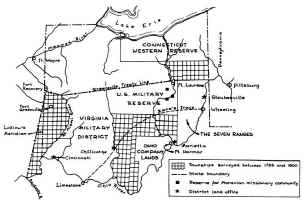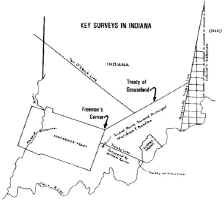In 1796 a new democracy, desperately poor, passed a Land Act, entitled:
"An Act providing for the Sale of the lands of the United States, in the
territory north-west of the river Ohio and above the mouth of the Kentucky
river". (This same land was won from the French in the French and Indian
War, relinquished by the British in the Treaty of Paris, and appropriated from
the Native Americans through years of battles and negotiations). Its provisions
created the office of Surveyor General, established the rectangular system,
decreed standards of land measurement, mandated recordkeeping and dictated the
base pay of deputy surveyors, their chain carriers and axemen. Under the new
law, President Washington appointed the former Revolutionary War Brigadier
General of the Army Engineers, Rufus Putnam, as the first federal Surveyor
General. Putnam's first order of business was to establish a field office in
Marietta, Ohio, and to hire surveyors to measure the Greenville Treaty Line.
The Treaty was the result of General "Mad Anthony" Wayne's victory
over the Native American tribes who defended their lands in "The Battle of
Fallen Timbers", August 1794. The Treaty "guaranteed that the American
settlement in Northwest Territory was secure from Indian attack as far west as a
line that met the Ohio River at a point opposite the mouth of the Kentucky
river".
 Putnam contracted Israel Ludlow to run the line that was to "permanently
separate white settlements from Indian villages and hunting grounds". As C.
Albert White narrates: "After delays waiting for an Indian and an Army
escort, Ludlow began the Treaty line in June 1797. He ran a random line from
Lorimies Store northeasterly toward Fort Lawrence, which intersected the
Tuscarawas at 153 miles, 20 miles south of the crossing place. Ludlow then
calculated a true line back and ran S.70 50'W. He blazed the line and set a post
every mile. This true line intersected Lorimies Creek, 23 1/2 chains upstream
north from the intended place. Ludlow reported these facts to Putnam and hoped
that the Indians wouldn't complain about the miss. Ludlow temporarily suspended
the survey of the treaty line. No attempt was made to correct back for the miss,
and that jog was left in the treaty line. But more importantly, it is the first
known record of a major survey line of the public land surveys being run random
and true. Although the Greenville Treaty line from the Tuscarawas Crossing to
Lorimies Creek is far from being a straight line and was certainly not a rhumb
line, it was a first major step in establishing some measure of limits of
closure." This survey would become both figurative and actual reference to
subsequent boundary negotiations and real lines on the ground.
Putnam contracted Israel Ludlow to run the line that was to "permanently
separate white settlements from Indian villages and hunting grounds". As C.
Albert White narrates: "After delays waiting for an Indian and an Army
escort, Ludlow began the Treaty line in June 1797. He ran a random line from
Lorimies Store northeasterly toward Fort Lawrence, which intersected the
Tuscarawas at 153 miles, 20 miles south of the crossing place. Ludlow then
calculated a true line back and ran S.70 50'W. He blazed the line and set a post
every mile. This true line intersected Lorimies Creek, 23 1/2 chains upstream
north from the intended place. Ludlow reported these facts to Putnam and hoped
that the Indians wouldn't complain about the miss. Ludlow temporarily suspended
the survey of the treaty line. No attempt was made to correct back for the miss,
and that jog was left in the treaty line. But more importantly, it is the first
known record of a major survey line of the public land surveys being run random
and true. Although the Greenville Treaty line from the Tuscarawas Crossing to
Lorimies Creek is far from being a straight line and was certainly not a rhumb
line, it was a first major step in establishing some measure of limits of
closure." This survey would become both figurative and actual reference to
subsequent boundary negotiations and real lines on the ground.
 Years before, and further west, the Indians had given the French a tract of
land containing 1.6 million acres, known as the Vincennes Tract. It was a
rectangular block lying at right angles to the course of the Wabash River at
Vincennes. By right of conquest, George Rogers Clark secured this land for the
United States and the Land Act of 1796 honored its boundaries. Before the
rectangular surveys could be extended to the Vincennes Tract, the outline had to
be surveyed. Deputy Surveyor Thomas Freeman began the survey in 1802. He was
"accompanied by chainman, axemen, hunters, a flagman, a cook, a packer, and
teamsters. Despite the rather small size of his party, they were not harassed,
and his survey was successful. Freeman's field notes reflect his care: he noted
such things as Indian Trails, large springs, creek crossings, and other
significant features. When he crossed Yellow Banks Indian Trail in his survey,
he recorded it as 31 miles and 41 chains from the mouth of the White River.
Occasionally, Freeman's men split a sapling and pushed a limb through its trunk.
These small trees that became large, enduring, oddly formed markers of a survey
line, were called "peace trees", as they marked a treaty line.
Years before, and further west, the Indians had given the French a tract of
land containing 1.6 million acres, known as the Vincennes Tract. It was a
rectangular block lying at right angles to the course of the Wabash River at
Vincennes. By right of conquest, George Rogers Clark secured this land for the
United States and the Land Act of 1796 honored its boundaries. Before the
rectangular surveys could be extended to the Vincennes Tract, the outline had to
be surveyed. Deputy Surveyor Thomas Freeman began the survey in 1802. He was
"accompanied by chainman, axemen, hunters, a flagman, a cook, a packer, and
teamsters. Despite the rather small size of his party, they were not harassed,
and his survey was successful. Freeman's field notes reflect his care: he noted
such things as Indian Trails, large springs, creek crossings, and other
significant features. When he crossed Yellow Banks Indian Trail in his survey,
he recorded it as 31 miles and 41 chains from the mouth of the White River.
Occasionally, Freeman's men split a sapling and pushed a limb through its trunk.
These small trees that became large, enduring, oddly formed markers of a survey
line, were called "peace trees", as they marked a treaty line.
Apparently, when Freeman was nearly finished with the survey, the United
States went back to before the French title and bought the land from the true
original owners - the Indians. Because of this precaution, any doubt about the
title was cleared away."
The northeast corner of the Vincennes Tract became known as "Freeman's
Corner" and was the starting point for the 1805 "Treaty of Grouseland".
Negotiated by then-Governor of the Indiana Territory William Henry Harrison, the
treaty gained more land from the Indians. The line ran northeasterly to
intersect a point on the Greenville Treaty Line fifty miles north of the Ohio
River. Arthur Henri, a United States Deputy Surveyor, was given this assignment.
In July 1806 he started running a line N 65 00' 00" E from Freeman's Corner
toward present day Brookville, Indiana. Eighty miles and 38 chains (2508 feet)
later, he crossed the line Ludlow had cut a decade earlier, but he was fifteen
miles too far south. He moved up Ludlow's line to the fifty mile post and
started back. Eighty-nine miles later, he crossed a Vincennes Tract line. Again
returning to Freeman's Corner, he proceeded easterly toward Brookville at N57
00' 00" E correcting his second line to the true treaty line, and
referencing his mile posts. Henri's field notes show that he ceased witnessing
his new points at mile number sixty-eight. (He probably intersected his second
line near there). Henri also lists the deviation of his magnetic compass from
true north at three points along the line. Therefore it would not be surprising
if deflections exist in the Grouseland Treaty Line between sixty and seventy
miles from Freeman's Corner. Today it still serves as a county line between
Ripley and Decatur Counties, as well as a boundary for numerous private
holdings.
Deputy Surveyors Ludlow, Freeman, and Henri were trailblazers; their surveys
opened up treaty lands for settlement which ultimately led to Ohio's statehood
in 1803, and Indiana's in 1819.
The Indiana Surveyors Historical Society in conjunction with the Franklin
County (IN) Historical Society completed a two year project to locate and
remonument the intersection point of the Greenville Treaty Line (1795) and the
Grouseland Treaty Line (1805). A public ceremony was held, where an Indiana
Historical Society marker and the monument at the intersection site were both
unveiled for the first time.
